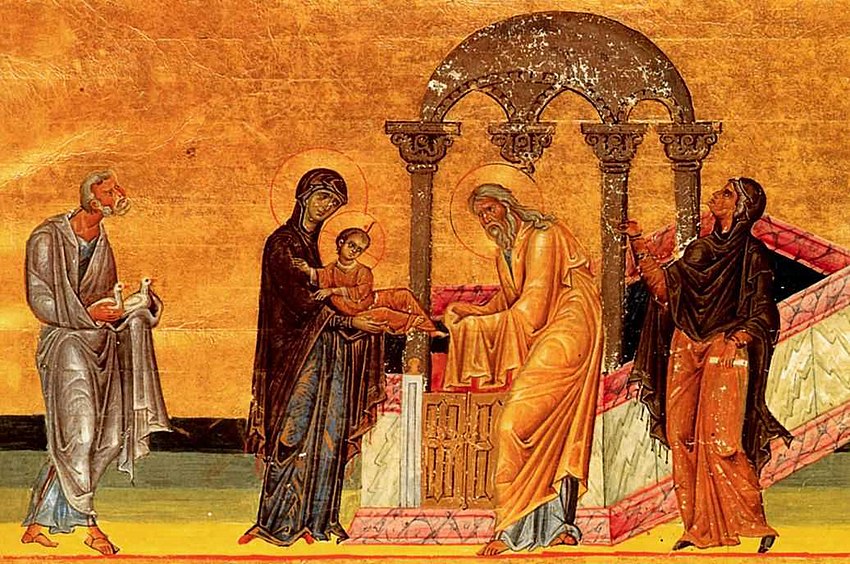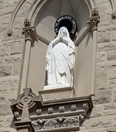Blog:"(and you yourself a sword will pierce)": an Easter reflection
Blog post: April 2, 2024 by Michael

At The Presentation in the Temple (Lk 2:34-36), the Evangelist tells us of Simeon's blessing of Mary and Joseph:
and Simeon blessed them and said to Mary his mother, “Behold, this child is destined for the fall and rise of many in Israel, and to be a sign that will be contradicted
(and you yourself a sword will pierce)
so that the thoughts of many hearts may be revealed.”
God speaks to us, St. Paul instructs us, "through his prophets in the holy scriptures" (Rm 1:2), but not always so plainly as Simeon to Mary:
(and you yourself a sword will pierce)
Making sense of scripture with the "Senses of Scripture"
I work with my RCIA students on interpreting Scripture through the "Senses of Scripture," which teach us to approach text at various levels, starting with the literal words.
(and you yourself a sword will pierce)
Literally.
Next, we are to look upon it allegorically: what's the larger idea? what does it represent? Then we are to consider it morally: what is the right and wrong God wants us to discern, which leads us to the anagogical, which asks where does it lead us?
What is the direct meaning of the words |

Next we must consider the context (con- "with" + text "come together, woven"). Simeon's prophesy to Mary is, importantly, parenthetical, placed amidst the prophesy that the child is "a sign that will be contradicted... ( ) ... so that the thoughts of many hearts may be revealed."
|
what does it mean more largely? |
 When we consider translations such as the NASB (1995) "and a sword will pierce even your own soul", we already have a directly allegorical statement (unless a "sword" can literally pierce a "soul" -- could be). Nevertheless, the analogy of the sword marks the pain Mary shall suffer as her child is "contradicted".
We can also extend Mary's pain, as was Jesus', to the sins and suffering of all humanity, especially as the New Eve. (More on that below.) |
what are the right and wrong?
|
Taking Simeon literally, "so that the thoughts of many hearts may be revealed," we understand that our beliefs and true selves we will be revealed and judged by the child.
More importantly, Simeon instructs that the child will be the instrument through which God will save "all peoples, a light for revelation to the Gentiles and glory for your people Israel" (Lk 2:31-32) |
where does it lead us? what are we supposed to do? |
Be ready, stay faithful, and while suffering will happen as consequence of belief, believe in the child we must. |
My analysis here is rudimentary, as with all things scriptural, the depths of meaning exceed any given perspective. But it is a start, and we can build from it larger context, which brings me to the Paschal mysteries.
"the fall and rise of many"
To repeat Simeon's prophesy, only without the parenthetical warning to Mary:
“Behold, this child is destined for the fall and rise of many in Israel, and to be a sign that will be contradicted ... so that the thoughts of many hearts may be revealed.”
The phrophesy will be fulfilled on the Cross and at the Resurrection. But what are we to make of the "fall and rise of many"?
Taking out our allegorical tool, we immediately look at the figurative sense of the words "fall" and "rise":
- fall = fall of Man (Adam and Eve) and, thus, sin
- rise = the resurrection, life ever after, salvation
And why, Simeon tells us, "so that the thoughts of many hearts may be revealed", which is judgment -- which Jesus later explains,is his (the child's) role:
"Nor does the Father judge anyone, but he has given all judgment to his Son" (Jn 5:22)
That we must take literally, so one can only marvel and wonder at Simeon's words to Mary and Joseph, and when the child was but a month old. Indeed, Simeon both summed up the life of Jesus and his mission.
Next up, we will consider the,
Types of Jesus and Mary
Another tool for understanding scripture is "typology," or, more largely, "Salvation History" and seeking how, to paraphrase St. Augustine, "the New Testament is hidden in the Old, and the Old Testament is revealed in the New." Christ fulfilled the Old Testament, so we learn about both the New and the Old Testaments through his actions in the New and what points to them in the Old.
In John 19:33-37, the Evangelist tells us such a revelation explicitly:
But when they came to Jesus and saw that he was already dead, they did not break his legs, but one soldier thrust his lance into his side, and immediately blood and water flowed out.
An eyewitness has testified, and his testimony is true; he knows that he is speaking the truth, so that you also may believe.
For this happened so that the scripture passage might be fulfilled:
“Not a bone of it will be broken.”
And again another passage says:
“They will look upon him whom they have pierced.”
(Jn 19:33-37),
John quotes or refers to Ex 12:46[2]; Nm 9:12[3]; Ps 34:21[4] literally. But, as we see from Luke, the parallels are just beginning with the direct Old Testament references.
(and you yourself a sword will pierce)
"[A]nd you yourself", also, Simeon tells Mary, means that a sword would pierce the child, as well. And there it is in John 19. Again, that's a direct connection we can easily draw using the literal sense of the scripture.
Let's get further into it, however, using the allegorical "sense of scripture".
The New Eve: typology of the Rib
There she is, Mary, Mother of God, at the foot of the cross, as her son is pierced with a sword. Mary, the New Eve, is pierced by the same sword, just as Eve herself was drawn from Adam's rib.
So we see Mary's role in this typology, but not just as the New Eve, also as Mother of the Church:
Blood and Water: the New Covenant
As Jesus is pierced by the sword, water and blood flow:
- the Garden was surrounded by flowing water.
- Blood is life.
- Water is baptism and cleansing.
And this is the blood of the New Covenant:
"my blood of the covenant, which will be shed on behalf of many for the forgiveness of sins." (Mt 26:28)
The blood and water that flow from Jesus's side, therefore are the new Church that Jesus instituted at the Last Supper.
There's more, of course:
Ezekial 47
John documented the piercing of Jesus' side to show that the prophesy of Ezekial came true:
Then he brought me back to the entrance of the temple, and there! I saw water flowing out from under the threshold of the temple toward the east, for the front of the temple faced east. The water flowed out toward the right side of the temple to the south of the altar. (Ez 47:1)
This is, of course, the "living water" Jesus spoke of at Jacob's Well (Jn 4:4-42). It's also the waters of the Church that,
He said to me, “This water flows out into the eastern district, runs down into the Arabah and empties into the polluted waters of the sea to freshen them.
"Polluted waters"? Sin. Freshen them? Baptism.
Fishermen will stand along its shore from En-gedi to En-eglaim; it will become a place for drying nets, and it will abound with as many kinds of fish as the Great Sea.
"Fishermen"? Well, we know a couple of them, one in particular upon whom Christ's Church was started.
The New Adam: typology of the Garden
Three days later, Mary Magdellin, who was at the foot of the Cross with Mary Mother of God, wept by the tomb. Distressed, she answered the two angels who asked her why she wept that,
“They have taken my Lord, and I don’t know where they laid him.” (Jn 20:13)
Then Jesus appeared to her and asked the same question,
Jesus said to her, “Woman, why are you weeping? Whom are you looking for?” She thought it was the gardener and said to him, “Sir, if you carried him away, tell me where you laid him, and I will take him.” (Jn 20:15)
Literally, the thought he was "the gardener" -- allegorically, which gardener, and which garden?
Here we have Jesus as the New Adam, the redemption of original sin and savior of the original Adam's people. But there's more. Mary wanted to know where the gardener had put the body: Mary's question is straight at the History of Salvation: Adam lost his way, was kicked out of the Garden, but now was found through Jesus Christ our Lord.
As with all Biblical typology, there's so much to learn, so many levels to discover. So let's call this a little start.
I'll keep adding more, as I think it through.
- Michael
- ↑ NASB Lk 2:35: "and a sword will pierce your own soul" KJV Lk 2:35 includes "also": "(Yea, a sword shall pierce through thy own soul also,)"
- ↑ and not leaving any of it over till morning, nor breaking any of its bones, but observing all the statutes of the Passover.
- ↑ and not leaving any of it over till morning, nor breaking any of its bones, but observing all the statutes of the Passover.
- ↑ He watches over all his bones; not one of them shall be broken.
